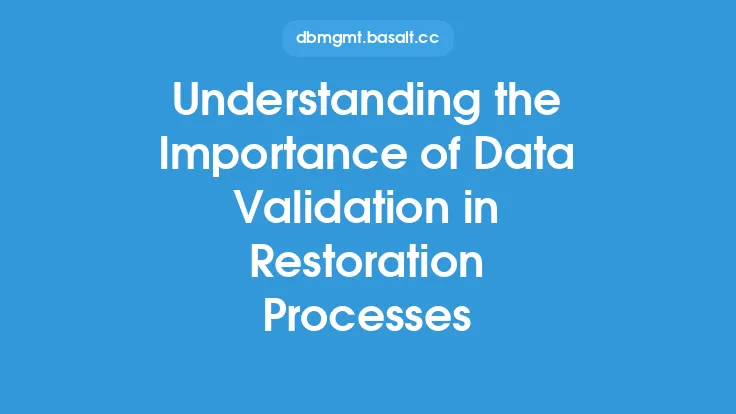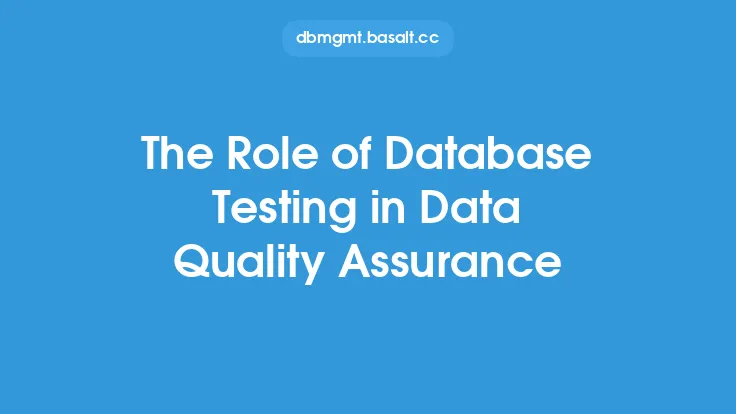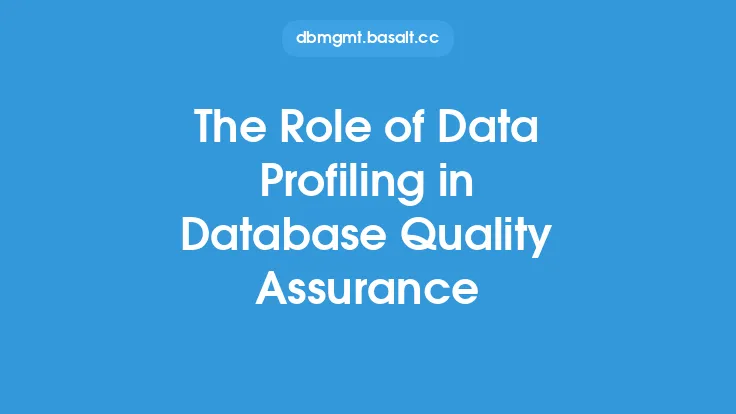Data quality plays a crucial role in effective restoration, as it directly impacts the reliability and accuracy of the restored data. In the context of database backup and recovery, data quality refers to the degree to which the data is accurate, complete, consistent, and reliable. High-quality data is essential for ensuring that the restored database is functional, efficient, and provides accurate information to support business operations.
Introduction to Data Quality
Data quality is a multifaceted concept that encompasses various aspects, including data accuracy, completeness, consistency, and reliability. In the context of data restoration, data quality is critical because it directly affects the usability and reliability of the restored data. Poor data quality can lead to incorrect or incomplete data, which can have severe consequences, including incorrect business decisions, financial losses, and damage to reputation. On the other hand, high-quality data ensures that the restored database is accurate, reliable, and provides a solid foundation for business operations.
The Impact of Data Quality on Restoration
Data quality has a significant impact on the restoration process, as it affects the accuracy and reliability of the restored data. Poor data quality can lead to a range of issues, including data inconsistencies, errors, and inaccuracies. These issues can be challenging to resolve, especially in large and complex databases. Moreover, poor data quality can also lead to data loss or corruption during the restoration process, which can result in significant financial losses and damage to reputation. On the other hand, high-quality data ensures that the restoration process is smooth, efficient, and accurate, resulting in a functional and reliable database.
Data Quality Metrics
To ensure high-quality data, it is essential to establish data quality metrics that measure the accuracy, completeness, consistency, and reliability of the data. These metrics can include data validation rules, data normalization rules, and data integrity constraints. Data validation rules ensure that the data is accurate and consistent, while data normalization rules ensure that the data is stored in a consistent format. Data integrity constraints, such as primary keys and foreign keys, ensure that the data is reliable and consistent. By establishing and enforcing these metrics, organizations can ensure that their data is of high quality, which is essential for effective restoration.
Data Quality Checks
Data quality checks are an essential part of the restoration process, as they ensure that the data is accurate, complete, and consistent. These checks can include data validation, data normalization, and data integrity checks. Data validation checks ensure that the data is accurate and consistent, while data normalization checks ensure that the data is stored in a consistent format. Data integrity checks ensure that the data is reliable and consistent, by verifying that the data conforms to the established data integrity constraints. By performing these checks, organizations can ensure that their data is of high quality, which is essential for effective restoration.
Data Quality Tools
There are various data quality tools available that can help organizations ensure high-quality data. These tools can include data validation tools, data normalization tools, and data integrity tools. Data validation tools ensure that the data is accurate and consistent, while data normalization tools ensure that the data is stored in a consistent format. Data integrity tools ensure that the data is reliable and consistent, by verifying that the data conforms to the established data integrity constraints. Some popular data quality tools include data profiling tools, data cleansing tools, and data monitoring tools. By using these tools, organizations can ensure that their data is of high quality, which is essential for effective restoration.
Best Practices for Ensuring Data Quality
To ensure high-quality data, organizations should follow best practices that include establishing data quality metrics, performing data quality checks, and using data quality tools. Additionally, organizations should ensure that their data is properly documented, and that data quality is continuously monitored and improved. This can be achieved by establishing a data quality framework that outlines the data quality metrics, data quality checks, and data quality tools to be used. By following these best practices, organizations can ensure that their data is of high quality, which is essential for effective restoration.
Conclusion
In conclusion, data quality plays a critical role in effective restoration, as it directly impacts the reliability and accuracy of the restored data. By establishing data quality metrics, performing data quality checks, and using data quality tools, organizations can ensure that their data is of high quality. Additionally, by following best practices that include proper documentation, continuous monitoring, and improvement, organizations can ensure that their data is accurate, complete, consistent, and reliable. By prioritizing data quality, organizations can ensure that their restoration processes are smooth, efficient, and accurate, resulting in a functional and reliable database that supports business operations.





